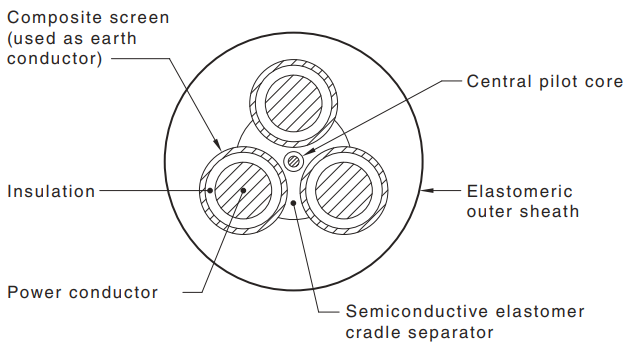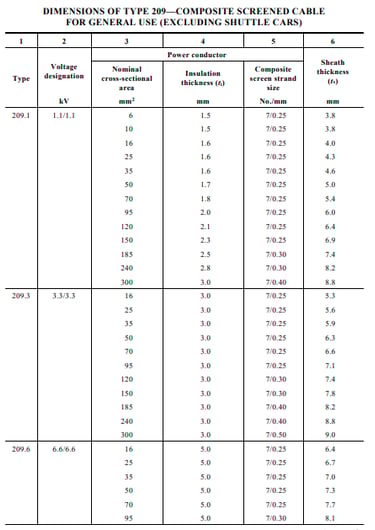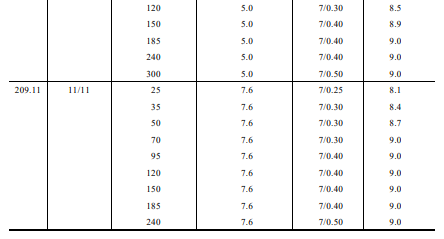AS/NZS 1802 Type 209 Mining Cable: Powering Australia’s Gold Mines
The AS/NZS 1802 standard sets out strict guidelines for mining cables in Australia and New Zealand, ensuring they can withstand the rugged conditions of mines while maintaining safety and performance. The Type 209 cable, available in voltage ratings from 1.1 kV to 11 kV, is a critical component in gold mining, powering everything from drills to conveyor systems. In this article, we’ll dive into its role in Australia’s gold mining industry, explore the country’s major gold mines, examine its application scenarios and technical specifications, and answer common questions miners might have about its use.
7/3/20257 min read


AS/NZS 1802 Type 209 Mining Cable: Powering Australia’s Gold Mines
Introduction
Gold mining has been a driving force in Australia’s economy for over a century, with the nation hosting some of the world’s most impressive gold mines. These operations, ranging from sprawling open pits to deep underground tunnels, depend on advanced machinery to extract gold efficiently. A key piece of technology underpinning this machinery is the mining cable, specifically the AS/NZS 1802 Type 209 cable. This composite-screened, flexible trailing cable is designed to deliver reliable power to underground machinery (excluding shuttle cars) in the harshest mining environments.
The AS/NZS 1802 standard sets out strict guidelines for mining cables in Australia and New Zealand, ensuring they can withstand the rugged conditions of mines while maintaining safety and performance. The Type 209 cable, available in voltage ratings from 1.1 kV to 11 kV, is a critical component in gold mining, powering everything from drills to conveyor systems. In this article, we’ll dive into its role in Australia’s gold mining industry, explore the country’s major gold mines, examine its application scenarios and technical specifications, and answer common questions miners might have about its use.
Overview of Major Australian Gold Mines
Australia’s gold mines are spread across its vast landscape, each with unique characteristics and production capacities. Here’s a look at some of the most significant:
Boddington (Western Australia)
Located in the Saddleback Greenstone Belt, Boddington is one of Australia’s largest gold producers, yielding around 590,000 ounces of gold annually. This open-pit mine has a rich history, having also produced copper in the past.Cadia Valley (New South Wales)
Near Orange, Cadia Valley is Australia’s top gold-copper mine, producing approximately 560,000 ounces of gold in the 2024 financial year. It combines open-pit and underground mining, making it a versatile operation.Kalgoorlie Super Pit (Western Australia)
Known simply as the “Super Pit,” this massive open-cut mine near Kalgoorlie is one of the country’s largest by scale. It’s an iconic symbol of Australia’s mining heritage and a major gold producer.Tropicana (Western Australia)
Situated in the Great Victoria Desert, Tropicana is a large open-pit mine operated as a joint venture. It consistently delivers significant gold output, contributing to Western Australia’s dominance in the industry.Other Key Mines
Tanami (Northern Territory): A mix of open-pit and underground operations in the remote Tanami Desert.
Telfer (Western Australia): A large mine in the Pilbara with both open-pit and underground components.
St Ives (Western Australia): Near Kambalda, featuring a combination of open-pit and underground mining.
Agnew (Western Australia): Primarily an underground mine near Leinster.
Wiluna (Western Australia): An open-pit and underground operation in the northern Goldfields.
These mines showcase the diversity of Australia’s gold mining industry, from vast surface operations to intricate underground networks. They all rely on robust power distribution systems, where the Type 209 cable plays an essential role.
Application Scenarios in Gold Mining
The Type 209 cable is a workhorse in gold mining, delivering power to a wide range of equipment across different environments. Its flexibility and durability make it ideal for trailing applications, where it follows mobile machinery over rough terrain.
Open-Pit Mining
In open-pit mines like Boddington and the Kalgoorlie Super Pit, the Type 209 cable powers heavy machinery such as excavators, haul trucks, and large drills. As these machines move across the pit, the cable trails behind, exposed to dust, rocks, and extreme weather. Its heavy-duty polychloroprene (PCP) sheath protects it from mechanical damage, while its flexibility allows it to adapt to constant movement.
For example, imagine a massive excavator digging into the earth at Boddington. The Type 209 cable snakes across the pit floor, delivering steady power as the machine shifts position. Its UV-resistant sheath ensures it can handle the harsh Australian sun, while its water-resistant design copes with occasional rain or runoff.
Underground Mining
In underground operations like Cadia Valley and Tanami, the cable supplies electricity to equipment such as drilling rigs, ventilation fans, pumps, and crushers. These environments are cramped and rugged, with narrow tunnels and rocky surfaces. The Type 209 cable’s composite earth screen—made of tinned braided copper and polyester yarn—provides both mechanical protection and a safe path for fault currents, critical in confined spaces where safety is paramount.
Picture a drilling rig deep underground at Cadia Valley. The Type 209 cable winds through the tunnel, powering the rig as it bores into the rock. Its abrasion-resistant sheath withstands scrapes against the walls, and its flame-resistant properties offer an extra layer of protection in case of emergencies.
Environmental Resilience
Gold mines present a host of challenges, including dust, moisture, temperature extremes, and mechanical stress. The Type 209 cable is built to handle them all:
Dust and Debris: Prevalent in open-pit mines, managed by the cable’s tough outer layer.
Moisture: Common underground, countered by the water-resistant PCP sheath.
Temperature Variations: From scorching outback heat to cooler underground conditions, the cable operates between -25°C and +90°C normally, with emergency ratings up to +130°C.
Mechanical Stress: Whether dragged across a pit or squeezed through a tunnel, its rugged design endures.
These qualities make the Type 209 cable a versatile and reliable choice for gold mining, ensuring continuous power in even the toughest scenarios.
Type 209 Cable Electrical & Physical Specifications
The Type 209 cable’s technical specifications are what make it so effective in mining. Let’s break down its key features and what they mean for gold mine operations.
Voltage Ratings
The cable comes in four variants to match different power needs:
Type 209.1: 1.1 kV
Type 209.3: 3.3 kV
Type 209.6: 6.6 kV
Type 209.11: 11 kV
These options allow it to support everything from small-scale equipment to large, high-voltage systems found in mines like the Super Pit or Cadia Valley.
Structural Components
Conductors: Flexible, stranded, tinned copper ensures flexibility and corrosion resistance. Tinning prevents oxidation, vital in humid underground conditions.
Conductor Screen:
1.1 kV uses a polyester barrier tape.
3.3 kV and above add a semiconductive tape or extruded layer to manage electrical stress.
Insulation: Ethylene-propylene rubber (EPR) offers high flexibility, heat resistance (up to +90°C normally), and oil resistance—perfect for mining’s harsh conditions.
Insulation Screen: A semiconductive elastomer or tape distributes electrical stress, preventing faults.
Composite Earth Screen: Tinned braided copper and polyester yarn provide mechanical strength and a fault current path, enhancing safety.
Central Pilot Core: A single EPR-insulated copper conductor for tension or monitoring, useful for safety systems or controlling cable movement.
Sheath: Heavy-duty PCP is flame-resistant, oil-resistant, and tough enough to withstand mining environments.
Dimensional Example (Type 209.11 at 11 kV)




Performance Characteristics
Temperature Ratings:
Normal: -25°C to +90°C
Emergency: Up to +130°C
Short-circuit: Up to +250°C for 5 seconds
This range ensures reliability in Australia’s variable climates.
Short-Circuit and Earth-Fault Capacity: Handles several kA (e.g., 1.8–7.9 kA for 1 second, depending on size), critical for safety during faults.
Flexibility and Ruggedness: The PCP sheath and braided screen make it ideal for trailing, resisting abrasion and bending stress.
Environmental Resistance: Water, flame, ozone, UV, and oil resistance ensure versatility in open-pit and underground settings.
Mechanical Tension: Built to withstand dynamic loads as it trails behind moving equipment.
These specs make the Type 209 cable a dependable power solution, tailored to the demands of gold mining.
Potential Mine-Use Challenges (FAQ Format)
Miners and engineers often have questions about using the Type 209 cable. Here are answers to some common concerns:
Q1: Can Type 209 be used as a reeling cable?
A: No, it’s designed for trailing, not continuous reeling. For reeling applications (e.g., shuttle cars), use Type 240 or 241 cables instead.
Q2: What’s the max conductor temperature during a heavy-load short-circuit?
A: It’s rated for +250°C for 5 seconds. Beyond that, prolonged heat could degrade the insulation, so fault detection systems are essential.
Q3: How do I select the correct voltage rating?
A: Match it to your mine’s power system—e.g., 11 kV for medium-voltage networks like those at Boddington or Cadia Valley. Consider future upgrades too.
Q4: Is there a risk of voltage drop in long trailing runs?
A: Yes, but it’s manageable. Use a larger conductor size (e.g., 240 mm²) to reduce resistance and voltage drop. Check voltage drop tables for your setup.
Q5: Are earth-fault and cable screening adequate underground?
A: Yes, the composite braided screen handles fault currents effectively. Pair it with proper grounding and regular inspections for maximum safety.
Q6: Is it suitable for wet or flooded areas?
A: The PCP sheath is water-resistant, but in prolonged wet conditions, inspect for sheath damage and repair or replace as needed.
Q7: How does it hold up in UV-exposed outdoor environments?
A: It’s UV-resistant, but in open-pit mines with intense sunlight, use cable trays or covers to extend its life. Check for cracking or discoloration periodically.
Conclusion & Best Practices
The AS/NZS 1802 Type 209 mining cable is a vital asset in Australia’s gold mining industry, powering machinery across iconic mines like Boddington, Cadia Valley, and the Kalgoorlie Super Pit. Its flexibility, durability, and safety features make it a go-to choice for both open-pit and underground operations.
To get the most out of it:
Choose the Right Voltage: Align with your mine’s network (e.g., 11 kV for larger systems).
Optimize Conductor Size: Balance current capacity and voltage drop, especially for long runs.
Enhance Safety: Use the pilot core for fault detection and ensure proper grounding.
Maintain Regularly: Inspect for wear, test insulation, and address damage promptly.
Monitor Performance: Log issues to guide maintenance and replacements.
As Australia’s gold mining industry grows, the Type 209 cable remains a reliable backbone, ensuring operations run safely and efficiently.

